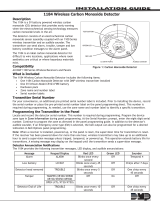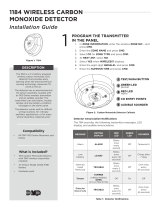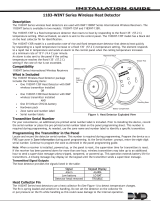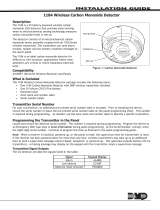5. HOW TO PERFORM A SURVEY
The communication between hub and detector start after the selection of the survey step on the hub device menu and stops when the survey
is stopped on the network device. The communication rate must be fast enough to assure a good stability of the quality link data shown.
The detector shows the link quality blinking the LEDs according to table 2 below:
5.1 Background Scan
The background RF Channel scan is an important first step before proceeding with the survey.
1. At the Main menu, enter in the SCAN menu
Once initiated, it will scan all available RF channels for congestion/noise for ~5 seconds per channel.
This process takes around 4 minutes to complete.
2. Once complete, a results table will be displayed with each RF channel listed in order of preference.
5.2 Point-to-point Survey
The point-to-point survey is used to determine the expected signal strength of each Taurus device at the potential install locations.
1. To begin the survey, from the Main Menu, select Survey.
2. Select the RF Channel number that you would like to survey with. This should be the channel listed during the Background Scan that we
performed first. Once input, select ‘Start Survey’.
3. You will be asked to ‘Toggle Device Switch…’. This prepares the mock detector with the RF channel to survey
To do this, remove the detector from the included base (rotate anti-clockwise) to expose the battery cover. Remove the battery
cover and install the included CR123 batteries. Now follow the on-screen instructions to toggle the device switch.
Note: The red switch position “ON” is active and 1 is “Dormant”
4. Once the device is powered on and paired to the Hub, the Hub should display a live read-out of signal strength in dBm. This is also indicat-
ed on the detector device via the LED (see table 2).
The LED readouts indicate suitability for a product to be installed in the location being tested.
Positive results = Green LED quick flash
Negative results = Red LED long flash
Results are often followed by a 1 second blank. The exception is the extremely bad result, to indicate range limit. Once this is exceeded, the
LED will no longer flash until it comes back in-range.
Marginal signal quality is indicated as not OK to install as this is likely lead to communication errors that require repeated transmission, lower-
ing device battery life.
Note: If the RF Channel pair being surveyed is changed - the point-to-point survey must be repeated for accurate results. This requires the
survey detector to be re-paired to the Hub.
Results of each survey point should be recorded.
Appendix A
THE UNIQUE IDENTIFIER (UUID)
The unique identifier is a 8 alphanumeric character sequence that univocally identifies every device that comes out of the factory; it is written
in every device’s permanent memory.
Unique identifier can be indicated as UID, UUID or Unique ID.
It is labelled below the QR code on each Hyfire device and it is encoded in the QR code.
Survey kit detector and network device carry a Unique ID number.
Table 2
Signal Quality LED Table
Rssi (dBm)
LED Acvity + Colour Signal Quality Ok to Install? Min. Max
0 -65 • • • -- Excellent
Yes -66 -75 • • • -- Good
-76 -80 • • • -- Sucient
-81 -85 -------- Marginal
No
-86 -90 -------- Bad
-91 -95 -------- Very bad
-96 -100 -------- Extremely bad
-101 -105 -------- Range limit

















